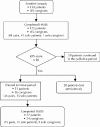Family caregiver burden: results of a longitudinal study of breast cancer patients and their principal caregivers
- PMID: 15184333
- PMCID: PMC419766
- DOI: 10.1503/cmaj.1031205
Family caregiver burden: results of a longitudinal study of breast cancer patients and their principal caregivers
Abstract
Background: The vital role played by family caregivers in supporting dying cancer patients is well recognized, but the burden and economic impact on caregivers is poorly understood. We prospectively examined the psychosocial, occupational and economic impact of caring for a person with a terminal illness.
Methods: We studied 89 caregivers of women with advanced breast cancer receiving care at either the Ottawa or Hamilton regional cancer centres in Ontario. Patients were followed until their death or study completion at 3 years. Patients identified a principal caregiver to participate in the study. The Karnofsky Performance Status (KPS) index, the Medical Outcomes Study 36-item Short Form (SF-36), the Hospital Anxiety and Depression Scale, the Zarit Burden Inventory, FAMCARE and the Medical Outcomes Study Social Support Survey were administered during follow-up. Economic data were collected by means of a questionnaire administered by an interviewer. Assessments were conducted every 3 months during the palliative period (KPS score > 50) and every 2 weeks during the terminal period (KPS score < or = 50).
Results: Over half of the caregivers were male (55%) and the patient's spouse or partner (52%), with a mean age of 53 years. At the start of the palliative period, the caregivers' mean physical functioning score was better than the patients' (51.3 v. 35.1, 95% confidence interval [CI] 13.3-20.0); there were similar mean mental functioning scores (46.6 and 47.1 respectively); similar proportions were depressed (11% and 12%); and significantly more caregivers than patients were anxious (35% v. 19%, p = 0.009). More caregivers were depressed (30% v. 9%, p = 0.02) and had a higher level of perceived burden (26.2 v. 19.4, p = 0.02) at the start of the terminal period than at the start of the palliative period. Burden was the most important predictor of both anxiety and depression. Of employed caregivers, 69% reported some form of adverse impact on work. In the terminal period 77% reported missing work because of caregiving responsibilities. Prescription drugs were the most important component of financial burden.
Interpretation: Caregivers' depression and perceived burden increase as patients' functional status declines. Strategies are needed to help reduce the psychosocial, occupational and economic burden associated with caregiving.
Figures
Comment in
-
Family care and burden at the end of life.CMAJ. 2004 Jun 8;170(12):1811-2. doi: 10.1503/cmaj.1040196. CMAJ. 2004. PMID: 15184336 Free PMC article. No abstract available.
References
-
- National Cancer Institute of Canada. Canadian Cancer Statistics 2002. Toronto: National Cancer Institute of Canada; 2002. p. 1-96.
-
- Subcommittee of the Standing Senate Committee on Social Affairs, Science and Technology. Quality end-of-life care: the right of every Canadian. Ottawa: The Senate of Canada; 2000. Available: www.parl.gc.ca/36/2/parlbus/commbus/senate/Com-e/upda-e/rep-e/repfinjun0... (accessed 2004 Feb 17).
Publication types
MeSH terms
LinkOut - more resources
Full Text Sources
Medical

